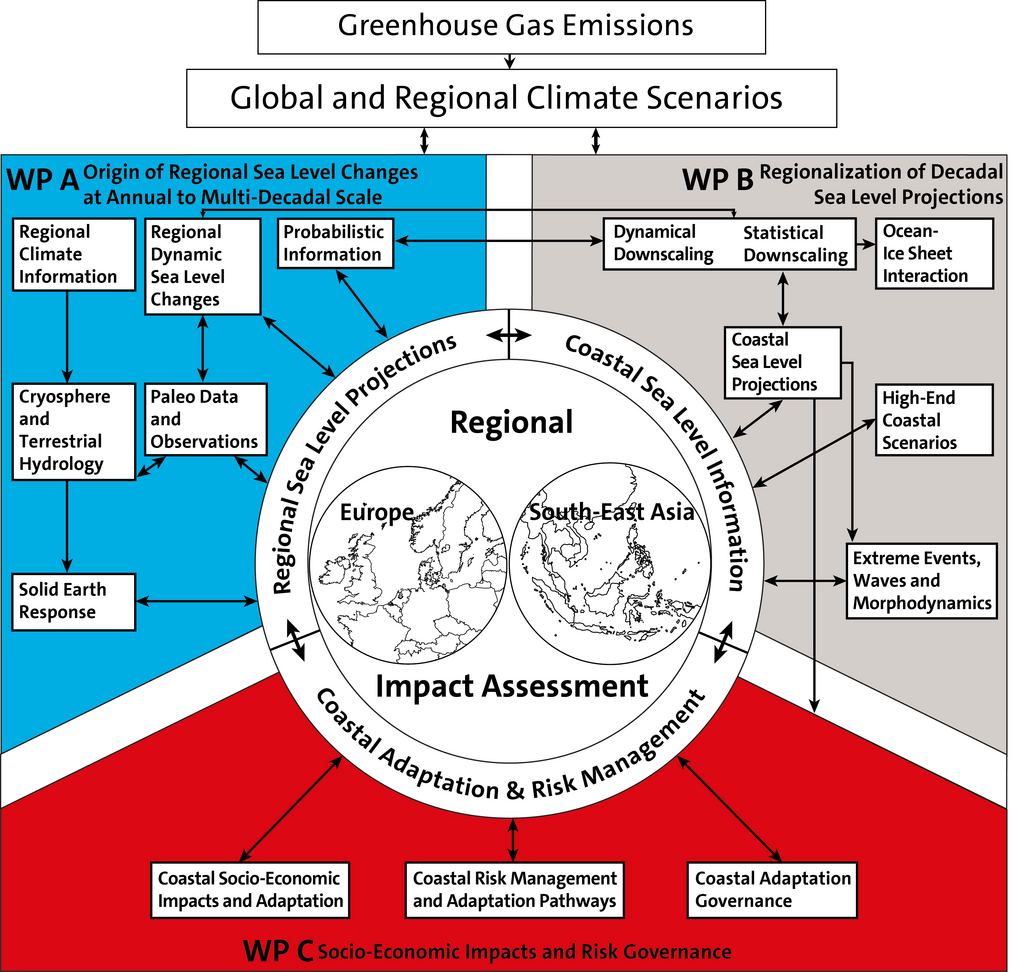Phase I
During the SeaLevel is organized along three work packages, which differ according to their spatial scale, their geographic foci but also with respect to the required participation from natural or social sciences.
As shown in Fig. 1, these work packages are all concerned with providing sea level information at coastal locations and studying the interactions between sea level changes and coastal societies. To foster interactions, SeaLevel work packages were planned around topics, not around disciplines.
WP A analyzes the mechanisms of sea level variability with primary focus on processes leading to spatially highly inhomogeneous patterns of regional seal level change on time scales of up to 50 years. The WP A will provide a comprehensive understanding of the natural and anthropogenic factors governing regional sea level variability. Respective work includes oceanographic, geodetic and cryospheric research on regional sea level patterns and also addresses terrestrial hydrological contributions. We will determine the origins of regional sea level changes at decadal to centennial time scales and identify the mechanisms causing coastal sea level changes on decadal time scales. To reach these goals the WP has to address also basin-scale to global data quality issues of in situ and satellite data. Results from WP A will provide knowledge of processes leading to sea level changes in the past, at present and in the future and will provide uncertainties in projected components. Such information is required as a boundary condition for coastal systems and their change on decadal to centennial time scales. Output from WP A will feed directly into WP B where an improved knowledge base will be created for coastal sea level change information with focus on the selected study regions. Output from WP A will also feed directly into WP C by providing regional climate information.
WP B is concerned with the establishment of a scientific basis for obtaining reliable local projections of sea level trends, thereby improving the scientific basis for providing quantitative and detailed (high-resolution and high-end) estimates of future coastal sea level changes in the two focus regions. WP B investigates the interaction of the large-scale ocean circulation with shelf seas and ice sheets on regional and local scale thereby downscaling climate related sea level information to coastal locations. It will provide new insight into small-scale processes related to the downscaling of sea level to coastal regions. The information will be merged with local geophysical processes controlling vertical motion of the solid earth and changes in coastline morphology. WP B thus involves regional studies to investigate specific geophysical processes relevant for coastal sea level changes, e.g. the relationship between ocean circulation and sea level changes in shelf regions, processes relating to interaction of ocean circulation and ice sheets, and sea level changes in specific coastal regions due to land movement (subsidence) and lateral inundation (morphodynamics) in interaction with regional sea level changes. New insight gained by WP B in terms of sea level change will feed into WP C by providing improved coastal sea level change scenarios for the selected pilot regions. Massive adaption measures (such as massive embankments) might contribute to changes in extreme sea levels. This in turn requires intensive work on explaining past changes in local sea level including those driven by human interventions.
WP C performs an integrated analysis of sea level change and human environment interactions in the selected two study regions, and aims to identify sea level stressors, coastal impacts, adaption pathways and policies for the studied regions. This involves the assessment of how coastal societies have coped with past coastal changes, the socio-economic consequences of future sea level changes to coastal and island societies, and the implications of possible regional and local adaptation and risk management strategies in sea level hot spots. WP C will also use and explore to what extent the sea level rise information generated in WP A and WP B is effective for analyzing large infrastructure and planning adaption decisions in the study regions. By answering questions about socio- economic implications, adaptation decisions and human–environment interactions, WP C will stimulate the creation of knowledge basis for quantitative coastal zone management studies. The insights generated in WP C is also essential for directing and readjusting the activities in the other WPs to make their outcome more useful for coastal communities. Thus results from WP C will feed back into WP A and WP B in terms of new questions asked and information requested.

